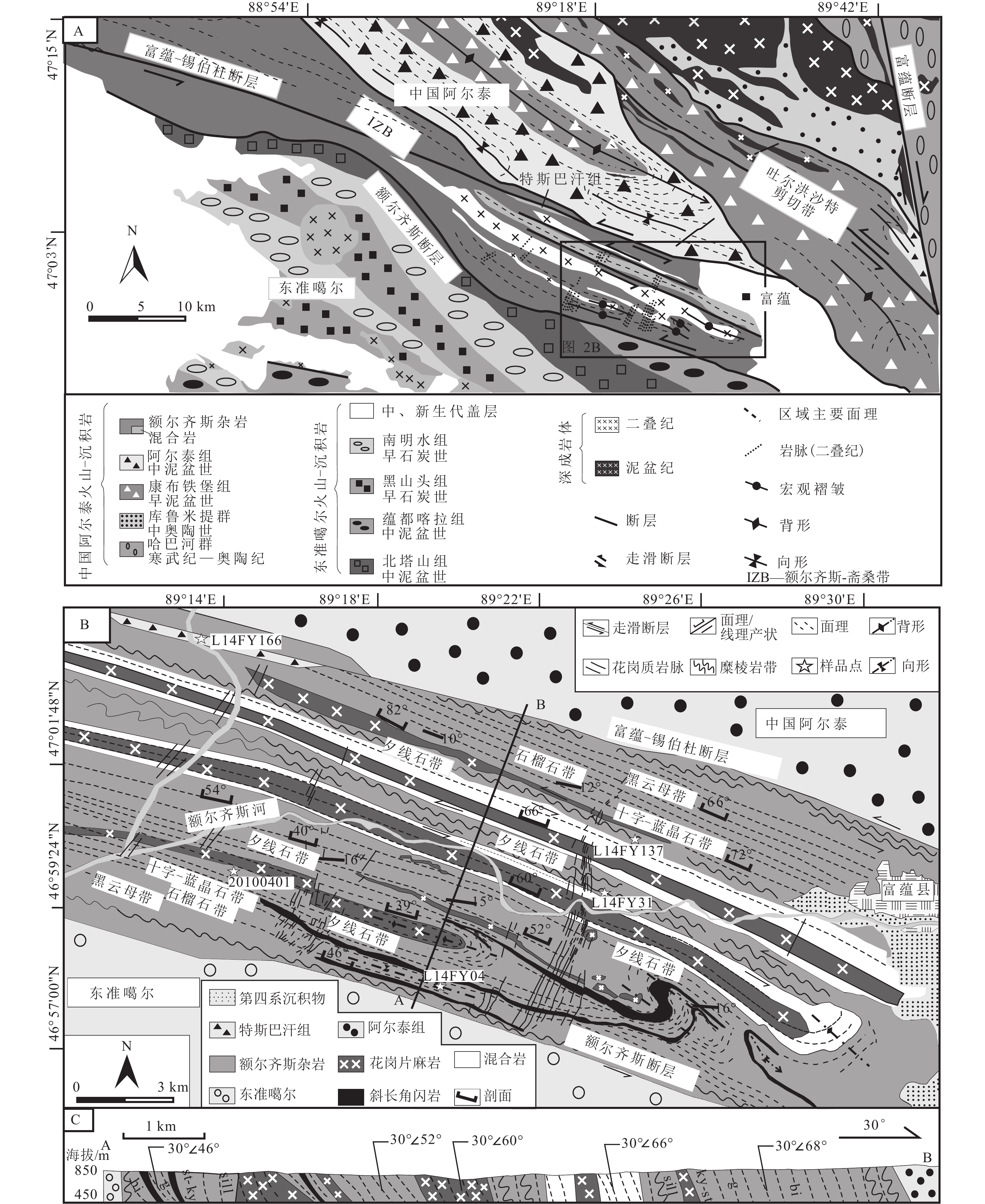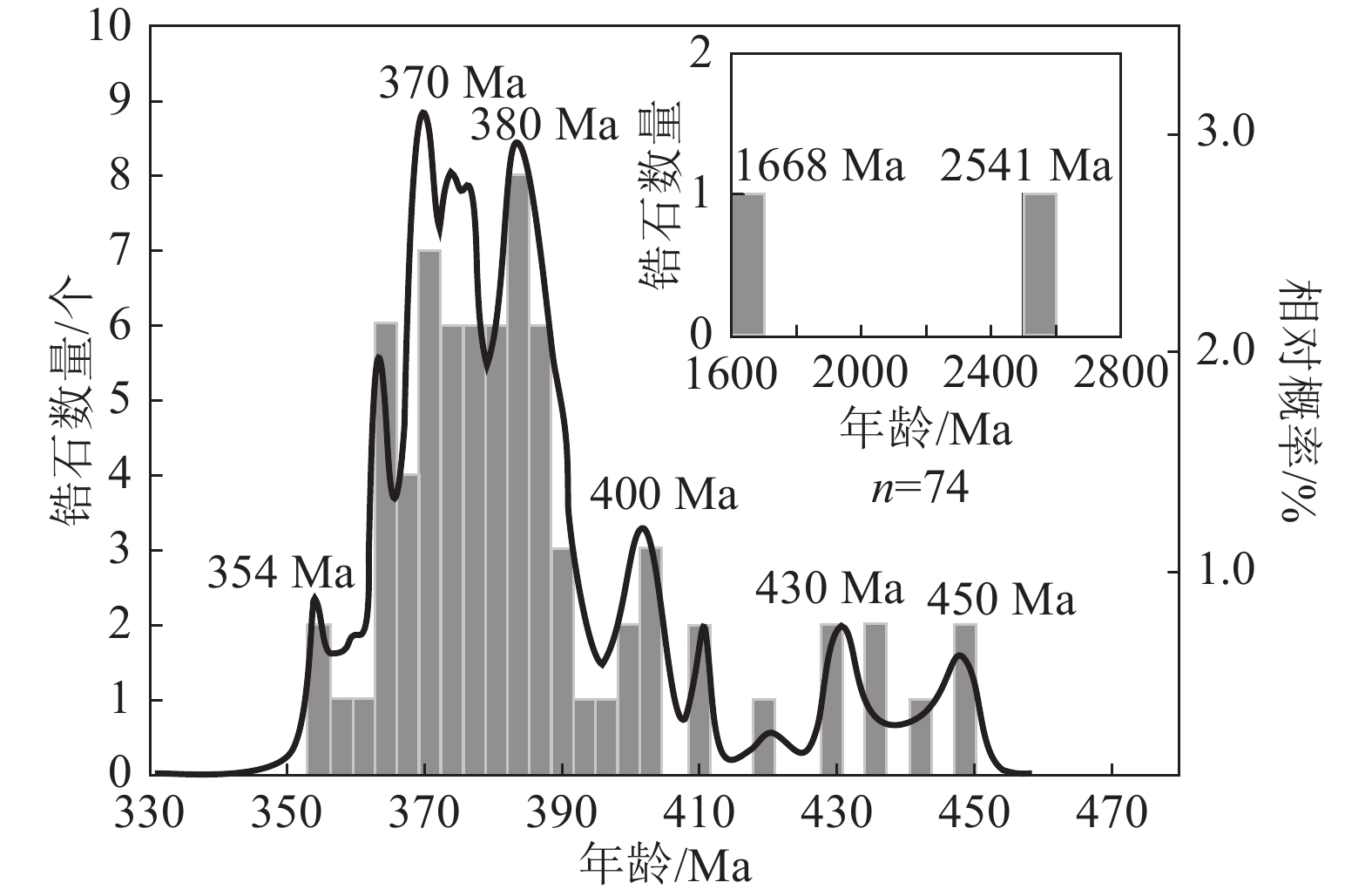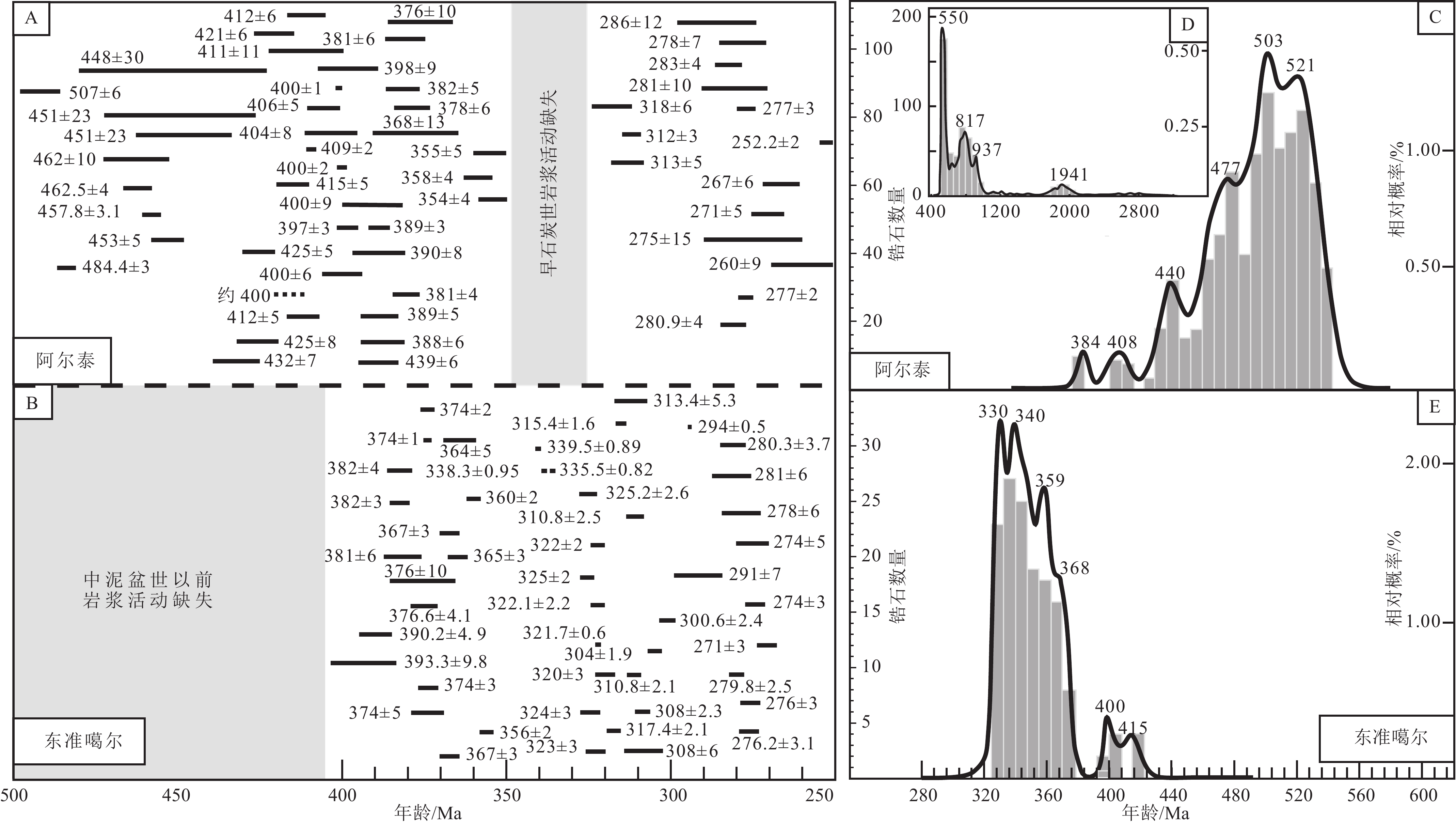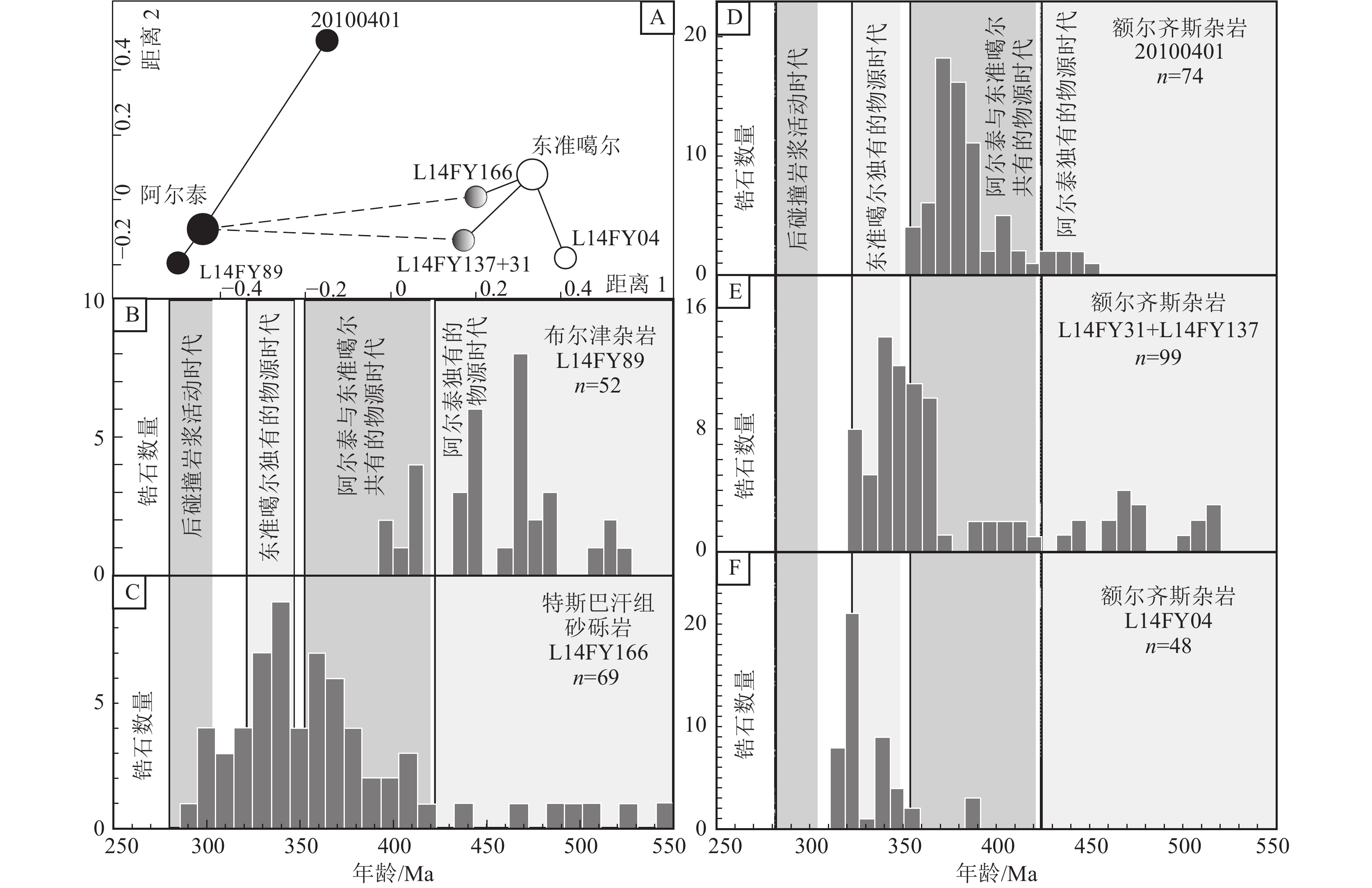Detrital zircon U−Pb ages from the Irtysh complex and its constraints on the amalgamation time of Altai and East Junggar terranes
-
摘要:
额尔齐斯杂岩位于新疆北部的阿尔泰和东准噶尔地体之间,经历了强烈的变质变形作用,记录了2个地体的构造拼合事件。为约束阿尔泰和东准噶尔地体的拼合时限,通过碎屑锆石U−Pb年龄分析探讨沉积物源。从变碎屑岩样品中获得最年轻的碎屑锆石年龄为354 Ma。在综合分析新的和已发表的碎屑锆石和区域构造年代学资料后,认为在额尔齐斯杂岩中,除同时以阿尔泰和东准噶尔地体为物源和以东准噶尔地体为单一物源的2类晚石炭世同碰撞沉积外,还可能包括较早以阿尔泰地体为单一物源的被动陆缘沉积,表明额尔齐斯杂岩形成时,阿尔泰和东准噶尔地体已经拼合。
Abstract:The Irtysh complex is located between Altai and East Junggar terranes in Northern Xinjiang and underwent strong metamorphism and deformation, which recorded the tectonic amalgamation of the two terrains. In order to constrain the amalgamation time of the Altai and East Junggar terrains, we used detrital zircon U−Pb ages to analyze and discuss the provenance. The youngest detrital zircon age obtained from the metaclastic rock sample is 354 Ma. Based on a comprehensive analysis of new and published detrital zircon U−Pb age data from the Irtysh complex and a comparison with regional tectonic and magmatic U−Pb age data, this paper proposes that the Irtysh complex may contain older detritus from the passive continental margin of the Altai terrane, in addition to the Late Carboniferous syn−collisional deposits from both of the Altai and East Junggar terranes and only the East Junggar terrane, suggesting that the Altai and East Junggar terranes had been amalgamated when the Irtysh complex was formed.
-
Key words:
- Irtysh complex /
- metaclastic rocks /
- provenance analysis /
- detrital zircon
-

-
图 1 额尔齐斯−斋桑带及邻区地质单元划分(A)和阿尔泰地质简图(B)(据Li et al., 2017)
Figure 1.
图 2 额尔齐斯−斋桑带东段地质简图(A)(据Li et al., 2017)、额尔齐斯杂岩地质构造简图(B,展示变质分带情况和采样点)(据Li et al., 2017)和剖面图(C)
Figure 2.
图 6 阿尔泰南部和东准噶尔北部的岩浆岩(A,B)和碎屑锆石(C~E)U−Pb年龄统计(数据来源于王中刚, 1998; Windley et al., 2002; Chen et al., 2004; Han et al., 2004; Wang et al., 2006, 2009, 2014a, b, 2021; Zhang et al., 2006; 2012, 2015, 2017; Briggs et al., 2007; Long et al., 2007, 2010; Yuan et al., 2007; 童英等, 2007; 周刚等, 2007; Sun et al., 2008, 2009; 刘锋等, 2008; 相鹏等, 2009; Gao et al., 2010; Jiang et al., 2011; Kozakov et al., 2011; Shen et al., 2011; Cai et al., 2010, 2011, 2012; Tong et al., 2012, 2014; 李香仁等, 2012; Liu et al., 2013; 李涤等, 2013; Li et al., 2014, 2016, 2017, 2019; 聂峰等, 2014; He et al., 2015; Zheng et al., 2016; Hong et al., 2017; Luo et al., 2017; Xu et al., 2017; Zhang et al., 2018; Niu et al., 2021; 汤贺军等, 2021)
Figure 6.
表 1 变碎屑岩样品20100401碎屑锆石U−Th−Pb同位素分析结果(mz-7为碎屑锆石边部的变质锆石测试点)
Table 1. U−Th−Pb data of detrital zircons from high-pressure granulite sample 20100401
点号 Th/U 同位素比值 年龄/Ma 谐和度/% 207Pb/235U 2σ 206Pb/238U 2σ rho 207Pb/206Pb 2σ 207Pb/235U 2σ 206Pb/238U 2σ 1 0.81 0.44 0.02 0.06 0.00 0.39 352 47 368.9 10.0 368.3 3.5 99.84 2 0.73 0.44 0.01 0.06 0.00 0.43 368 32 367.9 8.8 364.3 2.6 99.01 3 0.75 0.45 0.01 0.06 0.00 0.42 459 37 375.5 9.7 364.4 3.0 96.95 4 1.06 0.46 0.02 0.06 0.00 0.83 424 41 385.1 11.0 376.7 4.1 97.77 5 1.64 0.51 0.01 0.07 0.00 0.29 443 28 417.1 9.0 410.4 2.1 98.37 6 1.31 0.48 0.02 0.06 0.00 0.39 412 43 395.4 10.0 387.8 4.6 98.04 7 1.56 0.49 0.01 0.06 0.00 0.56 426 46 406.5 8.8 403.5 8.8 99.26 8 0.91 0.45 0.01 0.06 0.00 0.42 417 22 378.7 3.5 371.0 6.6 97.92 9 1.39 0.47 0.01 0.06 0.00 0.31 402 28 391.7 4.1 388.9 7.1 99.28 10 2.16 0.56 0.01 0.07 0.00 0.60 466 37 449.5 6.5 447.0 3.4 99.44 11 0.64 0.45 0.01 0.06 0.00 0.43 421 48 374.7 7.5 363.8 7.0 97.00 12 1.13 0.45 0.01 0.06 0.00 0.33 344 47 376.4 6.7 382.1 7.9 98.51 13 4.40 10.89 0.09 0.47 0.01 0.88 2542 6 2514.6 8.1 2478.0 40.0 97.43 14 1.16 0.47 0.01 0.06 0.00 0.51 451 34 392.8 5.9 383.2 7.4 97.49 15 1.11 0.46 0.01 0.06 0.00 0.66 404 39 384.3 7.9 381.2 9.0 99.19 16 0.91 0.44 0.01 0.06 0.00 0.50 389 32 373.7 5.0 370.9 7.1 99.25 17 1.98 0.52 0.01 0.07 0.00 0.50 388 41 429.1 7.5 435.7 9.7 98.49 18 1.00 0.45 0.01 0.06 0.00 0.45 392 38 376.3 6.1 375.7 7.9 99.84 19 0.78 0.45 0.01 0.06 0.00 0.61 442 30 376.0 5.4 364.7 6.7 96.90 20 1.90 0.51 0.01 0.07 0.00 0.52 331 44 418.8 8.0 435.6 10.0 96.14 21 1.24 0.46 0.01 0.06 0.00 0.50 394 44 385.9 6.7 384.7 7.8 99.69 22 1.17 0.46 0.01 0.06 0.00 0.30 376 38 381.7 5.8 383.4 7.2 99.56 23 1.28 0.50 0.01 0.06 0.00 0.46 540 47 409.8 7.9 387.8 8.1 94.33 24 1.58 0.49 0.01 0.07 0.00 0.62 403 25 406.7 5.0 408.5 8.0 99.56 25 1.41 0.47 0.01 0.06 0.00 0.60 383 42 389.1 6.8 390.8 5.0 99.56 26 2.27 0.55 0.01 0.07 0.00 0.55 433 39 447.4 6.5 449.6 3.4 99.51 27 1.08 0.45 0.01 0.06 0.00 0.59 354 54 375.2 8.8 378.4 4.8 99.15 28 0.61 0.42 0.01 0.06 0.00 0.35 404 40 359.6 5.0 356.9 2.1 99.24 29 0.83 0.44 0.01 0.06 0.00 0.28 372 54 369.0 7.3 368.8 3.3 99.95 30 2.01 0.55 0.02 0.07 0.00 0.64 409 47 443.4 9.8 443.7 6.3 99.93 31 1.49 0.49 0.01 0.06 0.00 0.63 418 48 403.9 8.9 400.8 5.5 99.23 32 0.95 0.45 0.01 0.06 0.00 0.56 397 36 376.8 5.0 373.8 2.1 99.20 33 0.61 0.42 0.01 0.06 0.00 0.33 370 45 355.7 6.0 353.7 2.2 99.43 34 0.86 0.43 0.01 0.06 0.00 0.46 314 54 362.3 7.7 369.3 4.0 98.10 35 1.34 0.46 0.01 0.06 0.00 0.72 357 38 383.6 6.2 387.9 4.2 98.89 36 0.90 0.43 0.01 0.06 0.00 0.48 345 37 364.7 4.9 370.2 2.2 98.51 37 0.62 0.44 0.01 0.06 0.00 0.35 406 42 366.7 6.0 362.6 2.4 98.87 38 1.52 0.47 0.01 0.06 0.00 0.56 371 40 393.7 5.8 401.5 3.3 98.06 39 0.90 0.46 0.01 0.06 0.00 0.48 501 35 387.6 5.0 370.7 1.9 95.44 40 1.12 0.47 0.01 0.06 0.00 0.41 372 50 392.0 8.1 381.5 2.9 97.25 41 1.42 0.49 0.02 0.06 0.00 0.36 426 63 407.9 10.0 393.1 3.8 96.24 42 0.90 0.45 0.01 0.06 0.00 0.36 404 56 379.7 8.9 370.1 3.1 97.41 43 1.70 0.53 0.02 0.07 0.00 0.37 438 56 431.8 10.0 430.0 4.1 99.58 44 1.15 0.46 0.01 0.06 0.00 0.31 387 52 381.1 8.5 383.0 2.8 99.50 45 1.27 0.46 0.01 0.06 0.00 0.42 432 52 386.7 8.8 386.1 3.4 99.84 46 2.31 3.96 0.08 0.28 0.00 0.83 1669 31 1627.4 18.0 1603.0 11.0 95.90 47 1.47 0.48 0.01 0.06 0.00 0.29 409 57 399.5 8.9 397.1 3.9 99.40 48 1.25 0.47 0.01 0.06 0.00 0.32 385 52 389.8 8.3 385.4 2.2 98.86 49 1.15 0.47 0.01 0.06 0.00 0.37 388 52 387.7 8.4 382.6 2.9 98.67 50 1.18 0.47 0.01 0.06 0.00 0.43 387 51 392.2 8.6 384.1 3.1 97.89 51 0.98 0.43 0.01 0.06 0.00 0.36 396 53 360.6 8.0 374.5 2.5 96.29 52 0.99 0.42 0.01 0.06 0.00 0.35 381 55 358.7 8.4 374.7 2.9 95.73 53 1.49 0.46 0.01 0.06 0.00 0.49 396 48 385.2 8.3 401.1 4.5 96.04 54 1.64 0.52 0.02 0.07 0.00 0.46 468 68 426.7 11.0 420.4 5.7 98.50 55 0.82 0.46 0.01 0.06 0.00 0.35 454 60 381.1 9.7 368.4 3.0 96.55 56 0.79 0.46 0.01 0.06 0.00 0.47 465 48 384.6 7.8 368.0 2.4 95.49 57 1.04 0.46 0.02 0.06 0.00 0.30 431 81 387.0 12.0 376.3 5.5 97.16 58 1.38 0.47 0.02 0.06 0.00 0.57 421 59 392.4 10.0 388.1 4.4 98.89 59 0.95 0.43 0.01 0.06 0.00 0.31 325 47 364.5 7.0 372.8 2.1 97.77 60 1.12 0.44 0.01 0.06 0.00 0.38 310 53 370.4 8.0 381.8 3.4 97.01 61 0.95 0.45 0.01 0.06 0.00 0.42 398 56 374.0 8.4 373.7 2.8 99.92 62 0.34 0.43 0.01 0.06 0.00 0.32 435 59 365.9 8.6 353.5 3.1 96.49 63 0.64 0.43 0.01 0.06 0.00 0.48 425 43 366.0 6.7 362.9 1.5 99.15 64 0.61 0.44 0.01 0.06 0.00 0.29 454 46 368.4 7.3 359.5 2.1 97.52 65 1.40 0.46 0.01 0.06 0.00 0.47 396 54 384.1 8.6 389.6 2.6 98.59 66 1.06 0.45 0.01 0.06 0.00 0.24 405 48 377.5 7.0 377.2 1.8 99.92 67 0.96 0.46 0.02 0.06 0.00 0.48 418 78 382.0 13.0 374.1 6.0 97.89 68 1.13 0.45 0.02 0.06 0.00 0.40 341 77 380.0 12.0 382.3 5.3 99.40 69 1.11 0.45 0.01 0.06 0.00 0.36 345 60 378.2 9.1 381.0 3.4 99.27 70 1.03 0.45 0.01 0.06 0.00 0.33 417 47 378.9 7.5 376.2 1.6 99.28 71 0.87 0.45 0.01 0.06 0.00 0.44 397 38 374.8 4.0 369.8 3.4 98.65 72 1.85 0.54 0.01 0.07 0.00 0.37 471 42 435.2 6.2 430.6 3.6 98.93 73 1.09 0.45 0.01 0.06 0.00 0.41 337 55 377.5 7.2 379.5 4.2 99.47 74 1.52 0.48 0.01 0.06 0.00 0.62 370 40 399.4 6.4 402.7 4.0 99.18 mz-7 0.01 0.33 0.00 0.04 0.00 0.42 306 29 286.4 3.5 283.0 5.2 98.80 注:谐和度(年龄< 1000 Ma)= 100%−│[207Pb/235U年龄 (Ma)−206Pb/238U年龄 (Ma)] / [207Pb/235U年龄 (Ma)]│*100%; 谐和度(年龄> 1000 Ma)= 100%−│[207Pb/206Pb年龄 (Ma)−206Pb/238Pb年龄 (Ma)] / [207Pb/206Pb年龄 (Ma)]│*100% -
[1] An R, Zhao G C, Liu Q, et al. 2021. Early Palaeozoic subduction−accretion in East Junggar (NW China): Insights from age, geochemical, and Sr−Nd−Hf isotopic data of andesitic rocks in the northern Yemaquan Arc[J]. Lithos, 380/381: 105892. doi: 10.1016/j.lithos.2020.105892
[2] Briggs S M, Yin A, Manning C E, et al. 2007. Late Paleozoic tectonic history of the Ertix Fault in the Chinese Altai and its implications for the development of the Central Asian Orogenic System[J]. Geological Society of America Bulletin, 119(7/8): 944−960. doi: 10.1130/B26044.1
[3] Broussolle A, Sun M, Schulmann K, et al. 2019. Are the Chinese Altai “terranes” the result of juxtaposition of different crustal levels during Late Devonian and Permian orogenesis?[J]. Gondwana Research, 66: 183−206. doi: 10.1016/j.gr.2018.11.003
[4] Buslov M M, Saphonova I Y, Watanabe T, et al. 2001. Evolution of the Paleo−Asian Ocean (Altai−Sayan Region, Central Asia) and collision of possible Gondwana−derived terranes with the southern marginal part of the Siberian continent[J]. Geosciences Journal, 5(3): 203−224. doi: 10.1007/BF02910304
[5] Buslov M M, Watanabe T, Fujiwara Y, et al. 2004. Late Paleozoic faults of the Altai region, Central Asia: tectonic pattern and model of formation[J]. Journal of Asian Earth Sciences, 23(5): 655−671. doi: 10.1016/S1367-9120(03)00131-7
[6] Cai K D, Sun M, Yuan C, et al. 2010. Geochronological and geochemical study of mafic dykes from the northwest Chinese Altai: Implications for petrogenesis and tectonic evolution[J]. Gondwana Research, 18(4): 638−652. doi: 10.1016/j.gr.2010.02.010
[7] Cai K D, Sun M, Yuan C, et al. 2011. Geological framework and Paleozoic tectonic history of the Chinese Altai, NW China: A review[J]. Russian Geology and Geophysics, 52(12): 1619–1633.
[8] Cai K D, Sun M, Yuan C, et al. 2012. Carboniferous mantle−derived felsic intrusion in the Chinese Altai, NW China: Implications for geodynamic change of the accretionary orogenic belt[J]. Gondwana Research, 22(2): 681−698. doi: 10.1016/j.gr.2011.11.008
[9] Chen B, Jahn B M. 2002. Geochemical and isotopic studies of the sedimentary and granitic rocks of the Altai orogen of northwest China and their tectonic implications[J]. Geological Magazine, 139(1): 1−13. doi: 10.1017/S0016756801006100
[10] Chen B, Jahn B M. 2004. Genesis of post−collisional granitoids and basement nature of the Junggar Terrane, NW China: Nd–Sr isotope and trace element evidence[J]. Journal of Asian Earth Sciences, 23: 691−703. doi: 10.1016/S1367-9120(03)00118-4
[11] Chen M, Sun M, Li P F, et al. 2019. Late Paleozoic Accretionary and Collisional Processes along the Southern Peri−Siberian Orogenic System: New Constraints from Amphibolites within the Irtysh Complex of Chinese Altai[J]. The Journal of Geology, 127(2): 241−262. doi: 10.1086/701253
[12] Gao F P, Zhou G, Lei Y X, et al. 2010. Early Permian granite age and geochemical characteristics in Shaerbulake of Xinjiang's Altai area and it's geoloigcal significance[J]. Geological Bulletin of China, 29(9): 1281−1293.
[13] Han B F, Ji J Q, Song B, et al. 2004. SHRIMP zircon U−Pb ages of Kalatongke No. 1 and Huangshandong Cu−Ni−bearing mafic−ultramafic complexes, North Xinjiang, and geological implications[J]. Chinese Science Bulletin, 49(22): 2424−2429.
[14] He Y L, Sun M, Cai K D, et al. 2015. Petrogenesis of the Devonian high−Mg rock association and its tectonic implication for the Chinese Altai orogenic belt, NW China[J]. Journal of Asian Earth Sciences, 113: 61−74. doi: 10.1016/j.jseaes.2015.02.014
[15] Hermann J, Rubatto D, Korsakov A, et al. 2001. Multiple zircon growth during fast exhumation of diamondiferous, deeply subducted continental crust (Kokchetav Massif, Kazakhstan)[J]. Contributions to Mineralogy and Petrology, 141(1): 66−82. doi: 10.1007/s004100000218
[16] Hong D W, Zhang J S, Wang T, et al. 2004. Continental crustal growth and the supercontinental cycle: evidence from the Central Asian Orogenic Belt[J]. Journal of Asian Earth Sciences, 23(5): 799−813. doi: 10.1016/S1367-9120(03)00134-2
[17] Hong T, Klemd R, Gao J, et al. 2017. The tectonic evolution of the Irtysh tectonic belt: New zircon U–Pb ages of arc−related and collisional granitoids in the Kalaxiangar tectonic belt, NW China[J]. Lithos, 272/273: 46−68. doi: 10.1016/j.lithos.2016.12.001
[18] Hu W W, Li P F, Rosenbaum G, et al. 2020. Structural evolution of the eastern segment of the Irtysh Shear Zone: Implications for the collision between the East Junggar Terrane and the Chinese Altai Orogen (northwestern China)[J]. Journal of Structural Geology, 139: 104126. doi: 10.1016/j.jsg.2020.104126
[19] Jessup M J, Langille J M, Cottle J M, et al. 2016. Crustal thickening, Barrovian metamorphism, and exhumation of midcrustal rocks during doming and extrusion: Insights from the Himalaya, NW India[J]. Tectonics, 35(1): 160−186. doi: 10.1002/2015TC003962
[20] Jiang Y D, Sun M, Zhao G C, et al. 2011. Precambrian detrital zircons in the Early Paleozoic Chinese Altai: Their provenance and implications for the crustal growth of central Asia[J]. Precambrian Research, 189(1): 140−154.
[21] Kozakov I K, Didenko A N, Azimov P Y, et al. 2011. Geodynamic settings and formation conditions of crystalline complexes in the south Altai and south Gobi metamorphic belts[J]. Geotectonics, 45(3): 174−194. doi: 10.1134/S0016852111030022
[22] Li D, He D F, Santosh M, et al. 2014. Petrogenesis of Late Paleozoic volcanics from the Zhaheba depression, East Junggar: Insights into collisional event in an accretionary orogen of Central Asia[J]. Lithos, 184/187: 167−193. doi: 10.1016/j.lithos.2013.10.003
[23] Li D, He D, Tang Y. 2016. Reconstructing multiple arc−basin systems in the Altai–Junggar area (NW China): Implications for the architecture and evolution of the western Central Asian Orogenic Belt[J]. Journal of Asian Earth Sciences, 121: 84−107. doi: 10.1016/j.jseaes.2016.02.010
[24] Li P F, Sun M, Rosenbaum G, et al. 2015. Structural evolution of the Irtysh Shear Zone (northwestern China) and implications for the amalgamation of arc systems in the Central Asian Orogenic Belt[J]. Journal of Structural Geology, 80: 142−156. doi: 10.1016/j.jsg.2015.08.008
[25] Li P F, Sun M, Rosenbaum G, et al. 2017. Late Paleozoic closure of the Ob−Zaisan Ocean along the Irtysh shear zone (NW China): Implications for arc amalgamation and oroclinal bending in the Central Asian orogenic belt [J]. Geological Society of America Bulletin, 129: B31541. 31541.
[26] Li P F, Sun M, Shu C T, et al. 2019. Evolution of the Central Asian Orogenic Belt along the Siberian margin from Neoproterozoic−Early Paleozoic accretion to Devonian trench retreat and a comparison with Phanerozoic eastern Australia[J]. Earth−Science Reviews, 198: 102951. doi: 10.1016/j.earscirev.2019.102951
[27] Liu W, Liu X J, Liu L J. 2013. Underplating generated A− and I−type granitoids of the East Junggar from the lower and the upper oceanic crust with mixing of mafic magma: Insights from integrated zircon U–Pb ages, petrography, geochemistry and Nd–Sr–Hf isotopes[J]. Lithos, 179: 293−319. doi: 10.1016/j.lithos.2013.08.009
[28] Liu Z, Bartoli O, Tong L X, et al. 2020. Permian ultrahigh–temperature reworking in the southern Chinese Altai: Evidence from petrology, P–T estimates, zircon and monazite U–Th–Pb geochronology[J]. Gondwana Research, 78: 20−40. doi: 10.1016/j.gr.2019.08.007
[29] Long X P, Sun M, Yuan C, et al. 2007. Detrital zircon age and Hf isotopic studies for metasedimentary rocks from the Chinese Altai: Implications for the Early Paleozoic tectonic evolution of the Central Asian Orogenic Belt [J]. Tectonics, 26(5).
[30] Long X P, Yuan C, Sun M, et al. 2010. Detrital zircon ages and Hf isotopes of the early Paleozoic flysch sequence in the Chinese Altai, NW China: New constrains on depositional age, provenance and tectonic evolution[J]. Tectonophysics, 480: 213−231. doi: 10.1016/j.tecto.2009.10.013
[31] Ludwig K R. 2012. Isoplot 3.75: A Geochronological Toolkit for Microsoft Excel[J]. Berkeley CA: Berkeley Geochronology Center Special Publication, 5: 1−75.
[32] Luo J, Xiao W J, Wakabayashi J, et al. 2017. The Zhaheba ophiolite complex in Eastern Junggar (NW China): Long lived supra−subduction zone ocean crust formation and its implications for the tectonic evolution in southern Altaids[J]. Gondwana Research, 43: 17−40. doi: 10.1016/j.gr.2015.04.004
[33] Niu L, Hong T, Xu X W, et al. 2021. Geochronology and trace elements of zircon in the Southern Chinese Altay: Implications for tectonic setting[J]. Geological Journal, 56: 3605−3625. doi: 10.1002/gj.4120
[34] Paton C, Hellstrom J, Paul B, et al. 2011. Iolite: Freeware for the visualisation and processing of mass spectrometric data[J]. Journal of Analytical Atomic Spectrometry, 26(12): 2508−2518. doi: 10.1039/c1ja10172b
[35] Safonova I Y, Simonov V A, Kurganskaya E V, et al. 2012. Late Paleozoic oceanic basalts hosted by the Char suture−shear zone, East Kazakhstan: Geological position, geochemistry, petrogenesis and tectonic setting[J]. Journal of Asian Earth Sciences, 49: 20−39. doi: 10.1016/j.jseaes.2011.11.015
[36] Shen X, Zhang H, Wang Q, et al. 2011. Late Devonian–Early Permian A−type granites in the southern Altay Range, Northwest China: Petrogenesis and implications for tectonic setting of “A2−type” granites[J]. Journal of Asian Earth Sciences, 42: 986−1007. doi: 10.1016/j.jseaes.2010.10.004
[37] Song S H, Xiao W J, Chen Y C, et al. 2020. Growth of an accretionary complex in the southern Chinese Altai: Insights from the Palaeozoic Kekesentao ophiolitic mélange and surrounding turbidites[J]. Geological Journal, 56(1): 265−283.
[38] Sun M, Yuan C, Xiao W J, et al. 2008. Zircon U–Pb and Hf isotopic study of gneissic rocks from the Chinese Altai: Progressive accretionary history in the early to middle Palaeozoic[J]. Chemical Geology, 247(3/4): 352−383. doi: 10.1016/j.chemgeo.2007.10.026
[39] Sun M, Long X P, Cai K D, et al. 2009. Early Paleozoic ridge subduction in the Chinese Altai: Insight from the abrupt change in zircon Hf isotopic compositions[J]. Science in China Series D: Earth Sciences, 52(9): 1345−1358. doi: 10.1007/s11430-009-0110-3
[40] Tao H F, Sun S, Wang Q C, et al. 2014. Petrography and geochemistry of lower carboniferous greywacke and mudstones in Northeast Junggar, China: Implications for provenance, source weathering, and tectonic setting[J]. Journal of Asian Earth Sciences, 87: 11−25. doi: 10.1016/j.jseaes.2014.02.007
[41] Taylor S R, Mclennan S M. 1995. The geochemical evolution of the continental crust[J]. Reviews of Geophysics, 33(2): 241−265. doi: 10.1029/95RG00262
[42] Tong L X, Xu Y G, Cawood P A, et al. 2014. Anticlockwise P−T evolution at ~280Ma recorded from ultrahigh−temperature metapelitic granulite in the Chinese Altai orogenic belt, a possible link with the Tarim mantle plume?[J]. Journal of Asian Earth Sciences, 94: 1−11. doi: 10.1016/j.jseaes.2014.07.043
[43] Tong Y, Wang T, Siebel W, et al. 2012. Recognition of early Carboniferous alkaline granite in the southern Altai orogen: post−orogenic processes constrained by U–Pb zircon ages, Nd isotopes, and geochemical data[J]. International Journal of Earth Sciences, 101(4): 937−950. doi: 10.1007/s00531-011-0700-0
[44] Tong Y, Wang T, Jahn B M, et al. 2014. Post−accretionary permian granitoids in the Chinese Altai orogen: Geochronology, petrogenesis and tectonic implications[J]. American Journal of Science, 314(1): 80−109. doi: 10.2475/01.2014.03
[45] Vermeesch P, Resentini A, Garzanti E. 2016. An R package for statistical provenance analysis[J]. Sedimentary Geology, 336: 14−25. doi: 10.1016/j.sedgeo.2016.01.009
[46] Wan B, Xiao W J, Windley B F, et al. 2013. Permian hornblende gabbros in the Chinese Altai from a subduction−related hydrous parent magma, not from the Tarim mantle plume[J]. Lithos, 5(3): 290−299. doi: 10.1130/L261.1
[47] Wang T, Hong D W, Jahn B M, et al. 2006. Timing, petrogenesis, and setting of Paleozoic synorogenic intrusions from the Altai Mountains, Northwest China: implications for the tectonic evolution of an accretionary orogeny[J]. The Journal of Geology, 114(6): 735−751. doi: 10.1086/507617
[48] Wang T, Jahn B M, Kovach V P, et al. 2009. Nd–Sr isotopic mapping of the Chinese Altai and implications for continental growth in the Central Asian Orogenic Belt[J]. Lithos, 110(1): 359−372.
[49] Wang T, Jahn B M, Kovach V P, et al. 2014a. Mesozoic intraplate granitic magmatism in the Altai accretionary orogen, NW China: implications for the orogenic architecture and crustal growth[J]. American Journal of Science, 314(1): 1−42. doi: 10.2475/01.2014.01
[50] Wang X H, Xu X W, Zhang B L, et al. 2021. Ore−forming mafic plutons emplaced at syn−collisional compressive setting in Kalatongke Ni–Cu sulphide district, Southern Altay, CAOB: New evidence from the Late Carboniferous granitic porphyries[J]. Geological Journal, 56(9): 4719−4734. doi: 10.1002/gj.4202
[51] Wang Y, Long X, Wilde S A, et al. 2014b. Provenance of Early Paleozoic metasediments in the central Chinese Altai: Implications for tectonic affinity of the Altai−Mongolia terrane in the Central Asian Orogenic Belt[J]. Lithos, 210–211: 57–68.
[52] Wei C J, Clarke G, Tian W, et al. 2007. Transition of metamorphic series from the Kyanite− to andalusite−types in the Altai orogen, Xinjiang, China: Evidence from petrography and calculated KMnFMASH and KFMASH phase relations[J]. Lithos, 96(3): 353−374.
[53] Weller O M, St−Onge M R, Waters D J, et al. 2013. Quantifying Barrovian metamorphism in the Danba Structural Culmination of eastern Tibet[J]. Journal of Metamorphic Geology, 31(9): 909−935. doi: 10.1111/jmg.12050
[54] Windley B F, Kröner A, Guo J H, et al. 2002. Neoproterozoic to Paleozoic Geology of the Altai Orogen, NW China: New Zircon Age Data and Tectonic Evolution[J]. The Journal of Geology, 110: 719−737. doi: 10.1086/342866
[55] Xiao W J, Windley B F, Yuan C, et al. 2009. Paleozoic multiple subduction−accretion processes of the southern Altaids[J]. American Journal of Science, 309(3): 221−270. doi: 10.2475/03.2009.02
[56] Xu X W, Li H, Peters S G, et al. 2017. Cu−rich porphyry magmas produced by fractional crystallization of oxidized fertile basaltic magmas (Sangnan, East Junggar, PR China)[J]. Ore Geology Reviews, 91: 296−315. doi: 10.1016/j.oregeorev.2017.09.020
[57] Yang X Q, Li Z L, Wang H H, et al. 2015. Petrology and geochemistry of ultrahigh−temperature granulites from the South Altay orogenic belt, northwestern China: Implications for metamorphic evolution and protolith composition[J]. Island Arc, 24(2): 169−187. doi: 10.1111/iar.12102
[58] Yuan C, Sun M, Xiao W, et al. 2007. Accretionary orogenesis of the Chinese Altai: insights from Paleozoic granitoids[J]. Chemical Geology, 242(1): 22−39.
[59] Zhang C L, Santosh M, Zou H B, et al. 2012. Revisiting the “Irtish tectonic belt”: Implications for the Paleozoic tectonic evolution of the Altai orogen[J]. Journal of Asian Earth Sciences, 52: 117−133. doi: 10.1016/j.jseaes.2012.02.016
[60] Zhang C, Liu L F, Santosh M, et al. 2017. Sediment recycling and crustal growth in the Central Asian Orogenic Belt: Evidence from Sr–Nd–Hf isotopes and trace elements in granitoids of the Chinese Altay[J]. Gondwana Research, 47: 142−160. doi: 10.1016/j.gr.2016.08.009
[61] Zhang C, Luo Q, Zhang X, et al. 2018. Geochronological, geochemical, and Sr–Nd–Hf isotopic studies of the Aketas adakitic granites in Eastern Junggar: Petrogenesis and tectonic implications[J]. Geological Journal, 53: 80−101. doi: 10.1002/gj.2879
[62] Zhang Z C, Yan S H, Chen B L, et al. 2006. SHRIMP zircon U−Pb dating for subduction−related granitic rocks in the northern part of east Jungaar, Xinjiang[J]. Chinese Science Bulletin, 51: 952−962. doi: 10.1007/s11434-008-0952-7
[63] Zhang Z C, Zhou G, Kusky T M, et al. 2009. Late Paleozoic volcanic record of the Eastern Junggar terrane, Xinjiang, Northwestern China: Major and trace element characteristics, Sr–Nd isotopic systematics and implications for tectonic evolution[J]. Gondwana Research, 16(2): 201−215. doi: 10.1016/j.gr.2009.03.004
[64] Zhang J, Sun M, Schulmann K, et al. 2015. Distinct deformational history of two contrasting tectonic domains in the Chinese Altai: Their significance in understanding accretionary orogenic process[J]. Journal of Structural Geology, 73: 64−82. doi: 10.1016/j.jsg.2015.02.007
[65] Zheng J, Chai F, Yang F. 2016. The 401–409 Ma Xiaodonggou granitic intrusion: implications for understanding the Devonian Tectonics of the Northwest China Altai orogeny[J]. International Geology Review, 58(5): 540−555. doi: 10.1080/00206814.2015.1095131
[66] 陈立辉, 韩宝福. 2006. 新疆北部乌恰沟地区镁铁质侵入岩的年代学、地球化学和Sr−Nd−Pb同位素组成: 对地幔源区特征和深部过程的约束[J]. 岩石学报, 22(5): 1201−1214. doi: 10.3321/j.issn:1000-0569.2006.05.012
[67] 李长民. 2009. 锆石成因矿物学与锆石微区定年综述[J]. 地质调查与研究, 32(3): 161−174.
[68] 李涤, 何登发, 樊春, 等. 2013. 东准噶尔早二叠世后碰撞岩浆活动: 蕴都卡拉流纹岩SHRIMP U−Pb年代学、地球化学和Hf同位素的制约[J]. 岩石学报, 29(1): 317−337.
[69] 李香仁, 刘锋, 杨富全. 2012. 阿尔泰克因布拉克铜锌矿区二云母正长花岗岩成岩时代及地质意义[J]. 新疆地质, 30(1): 5−11. doi: 10.3969/j.issn.1000-8845.2012.01.002
[70] 刘锋, 李延河, 毛景文, 等. 2008. 阿尔泰造山带阿巴宫花岗岩体锆石SHRIMP年龄及其地质意义[J]. 地球学报, 29(6): 795−804.
[71] 聂峰, 田晓丽, 李振生. 2014. 东准造山带原泥盆系的形成时代及源区: 碎屑锆石U−Pb年代学证据[J]. 地质科学, 49: 695−717.
[72] 汤贺军, 孟贵祥, 王召林. 2021. 新疆东准噶尔扎河坝一带碱性花岗岩锆石U−Pb年代学、Lu−Hf同位素特征及地质意义[J]. 地质论评, 67(S1): 67−68.
[73] 童英, 王涛, 洪大卫, 等. 2005. 阿尔泰造山带西段同造山铁列克花岗岩体锆石U−Pb年龄及其构造意义[J]. 地球学报, 26: 74−77. doi: 10.3321/j.issn:1006-3021.2005.z1.026
[74] 童英, 洪大卫, 王涛, 等. 2006. 阿尔泰造山带南缘富蕴后造山线形花岗岩体锆石U−Pb年龄及其地质意义[J]. 岩石矿物学杂志, 25(2): 85−89. doi: 10.3969/j.issn.1000-6524.2006.02.001
[75] 童英, 王涛, 洪大卫, 等. 2007. 中国阿尔泰北部山区早泥盆世花岗岩的年龄、成因及构造意义[J]. 岩石学报, 23(8): 1933−1944. doi: 10.3969/j.issn.1000-0569.2007.08.014
[76] 王涛, 童英, 李舢, 等. 2010. 阿尔泰造山带花岗岩时空演变、构造环境及地壳生长意义——以中国阿尔泰为例[J]. 岩石矿物学杂志, 29(6): 595−618. doi: 10.3969/j.issn.1000-6524.2010.06.002
[77] 王中刚, 1998. 阿尔泰花岗岩类地球化学[M]. 北京:科学出版社.
[78] 相鹏, 张连昌, 吴华英, 等. 2009. 新疆青河卡拉先格尔铜矿带Ⅱ−Ⅲ矿区含矿斑岩锆石年龄及地质意义[J]. 岩石学报, 25: 1474−1483.
[79] 袁峰, 周涛发, 岳书仓. 2001. 阿尔泰诺尔特地区花岗岩形成时代及成因类型[J]. 新疆地质, 19(4): 292−296. doi: 10.3969/j.issn.1000-8845.2001.04.013
[80] 周刚, 张招崇, 王新昆, 等. 2007. 新疆玛因鄂博断裂带中花岗质糜棱岩锆石U−Pb SHRIMP和黑云母40Ar−39Ar年龄及意义[J]. 地质学报, 81(3): 359−369. doi: 10.3321/j.issn:0001-5717.2007.03.008
-



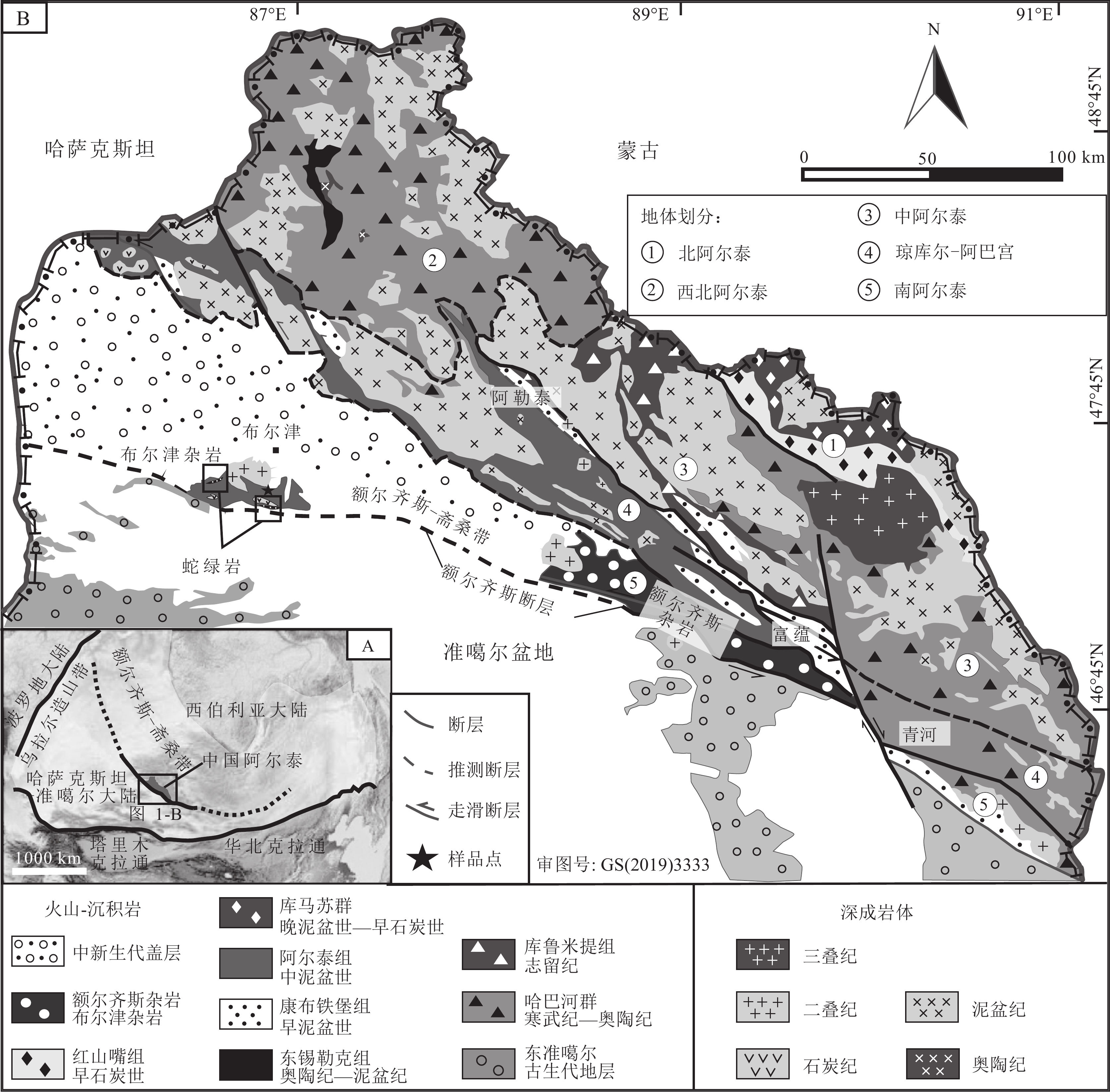
 下载:
下载:
